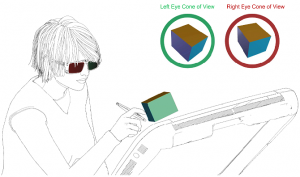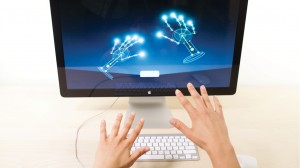The issue that I was having last week with two images appearing was fixed today. The solution to this problem was to make the inter-Pupillary Distance (IPD) smaller. The IPD is the distance between the two pupils of the viewers eyes. By making this value smaller, it made the two images that are rendered in the world builder application appear closer together. Below is an image demonstrating this.
At first I thought this could be a problem with the Nvidia Quadro drivers, and luckily it wasn’t. The next step is to get the Stylus operating within the world builder application. The plan is to spoof the current code for the joystick and use it with the stylus. After this is complete I believe it would be beneficial to get the world builder application to run with out the skeletal viewer. Doing this would decrease start up time and will improve the speed of the world builder when using the leap motion.
UPDATE:
Stylus is now being detect in the world builder application. Next step is to add some type of beem or cursor to the stylus. After this is accomplished I can map the key bindings so that you can select and rotate an object in the world builder app.






